TOP 492 Management and Operation Report
VerifiedAdded on 2020/01/07
|17
|5102
|179
Report
AI Summary
This report provides a comprehensive analysis of leadership and operations management, focusing on the roles of leaders and managers, relevant theories, and their application in a business context, specifically using M&S Ltd as a case study. It covers key operational functions, the significance of operations management for achieving business objectives, and the impact of environmental factors on decision-making. The report also includes recommendations for future growth and sustainability, emphasizing the importance of effective leadership, communication, and operational strategies. The analysis is supported by various management theories and models, providing a detailed understanding of the subject matter.
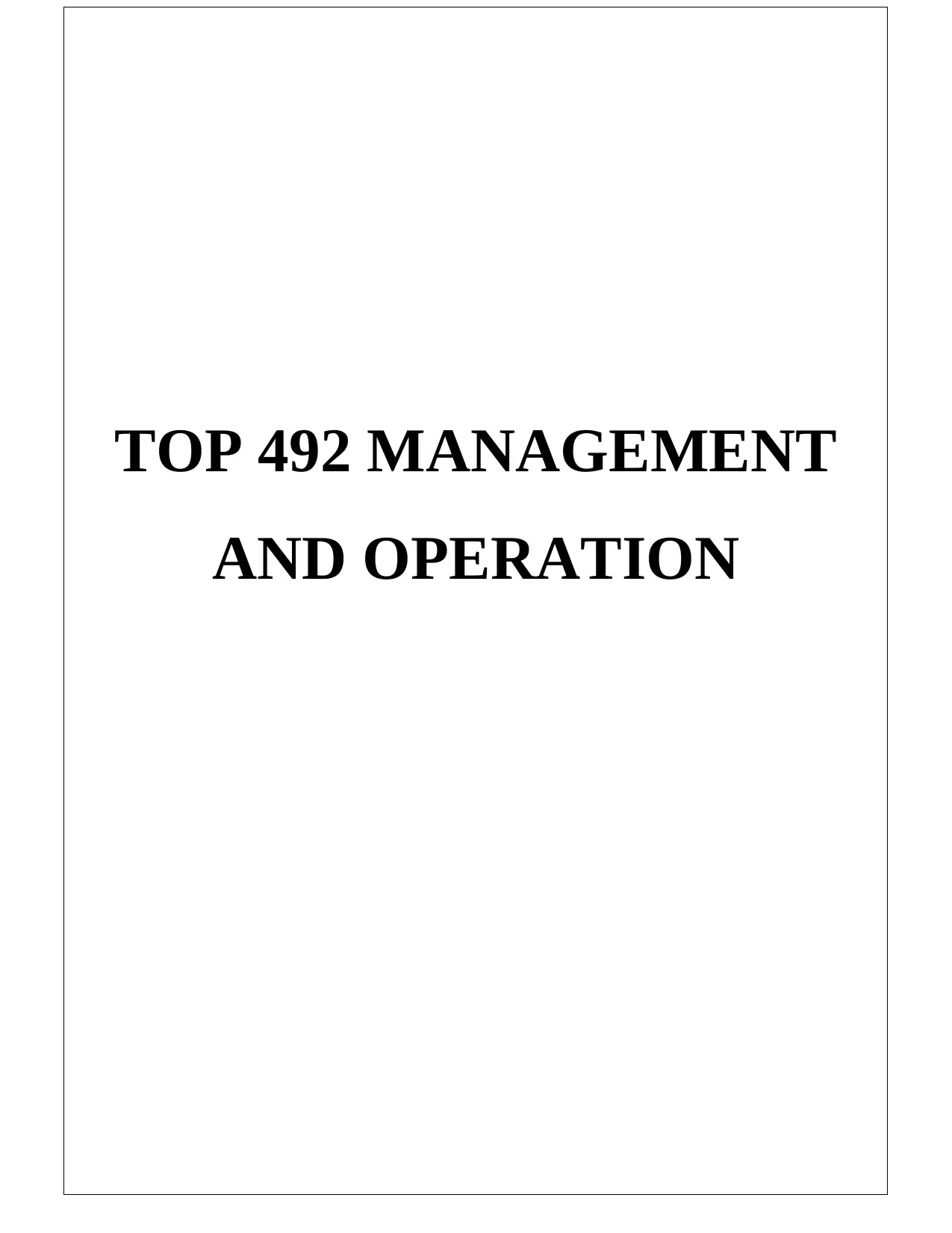
TOP 492 MANAGEMENT
AND OPERATION
AND OPERATION
Paraphrase This Document
Need a fresh take? Get an instant paraphrase of this document with our AI Paraphraser
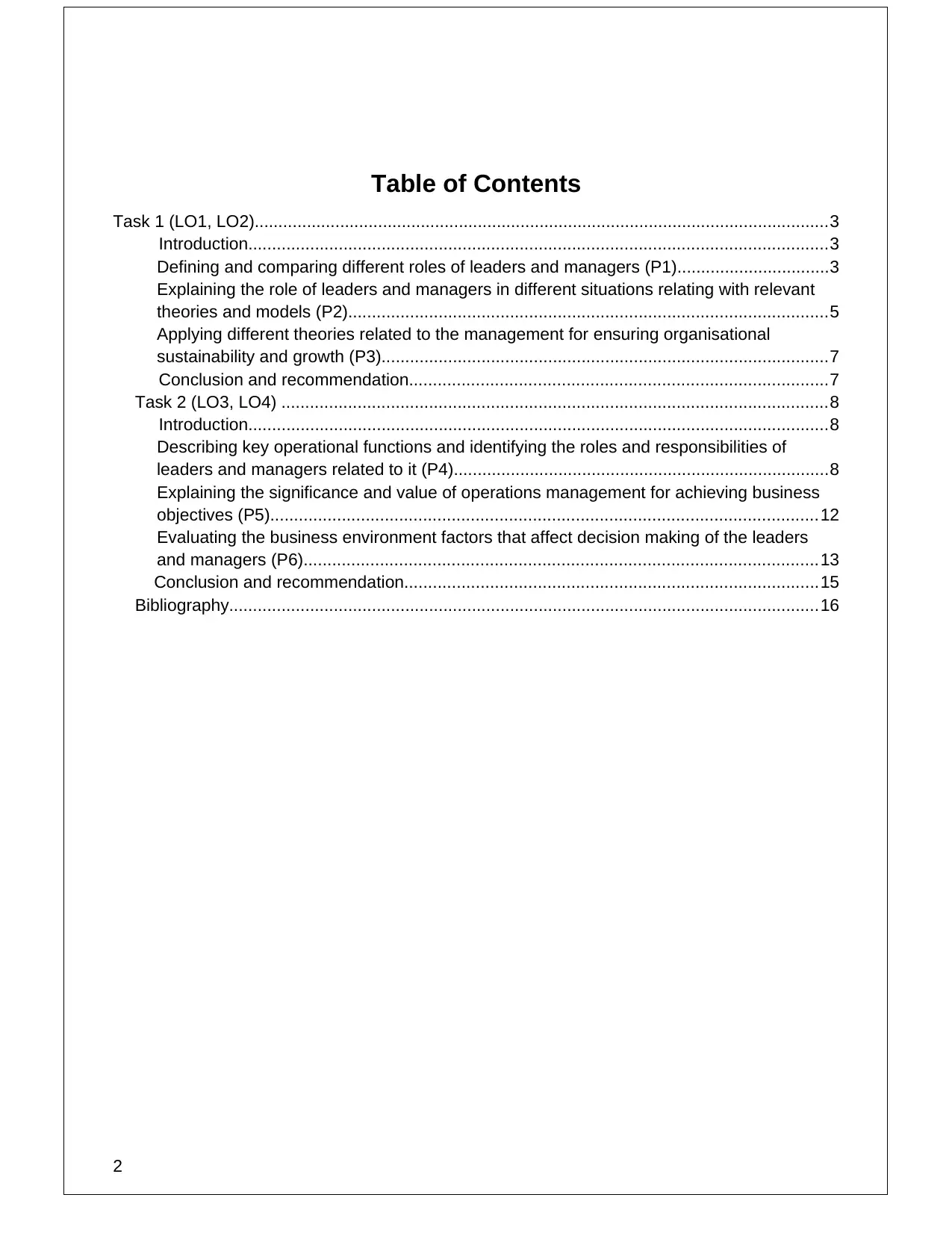
Table of Contents
Task 1 (LO1, LO2).........................................................................................................................3
Introduction..........................................................................................................................3
Defining and comparing different roles of leaders and managers (P1)................................3
Explaining the role of leaders and managers in different situations relating with relevant
theories and models (P2).....................................................................................................5
Applying different theories related to the management for ensuring organisational
sustainability and growth (P3)..............................................................................................7
Conclusion and recommendation........................................................................................7
Task 2 (LO3, LO4) ...................................................................................................................8
Introduction..........................................................................................................................8
Describing key operational functions and identifying the roles and responsibilities of
leaders and managers related to it (P4)...............................................................................8
Explaining the significance and value of operations management for achieving business
objectives (P5)...................................................................................................................12
Evaluating the business environment factors that affect decision making of the leaders
and managers (P6)............................................................................................................13
Conclusion and recommendation.......................................................................................15
Bibliography............................................................................................................................16
2
Task 1 (LO1, LO2).........................................................................................................................3
Introduction..........................................................................................................................3
Defining and comparing different roles of leaders and managers (P1)................................3
Explaining the role of leaders and managers in different situations relating with relevant
theories and models (P2).....................................................................................................5
Applying different theories related to the management for ensuring organisational
sustainability and growth (P3)..............................................................................................7
Conclusion and recommendation........................................................................................7
Task 2 (LO3, LO4) ...................................................................................................................8
Introduction..........................................................................................................................8
Describing key operational functions and identifying the roles and responsibilities of
leaders and managers related to it (P4)...............................................................................8
Explaining the significance and value of operations management for achieving business
objectives (P5)...................................................................................................................12
Evaluating the business environment factors that affect decision making of the leaders
and managers (P6)............................................................................................................13
Conclusion and recommendation.......................................................................................15
Bibliography............................................................................................................................16
2
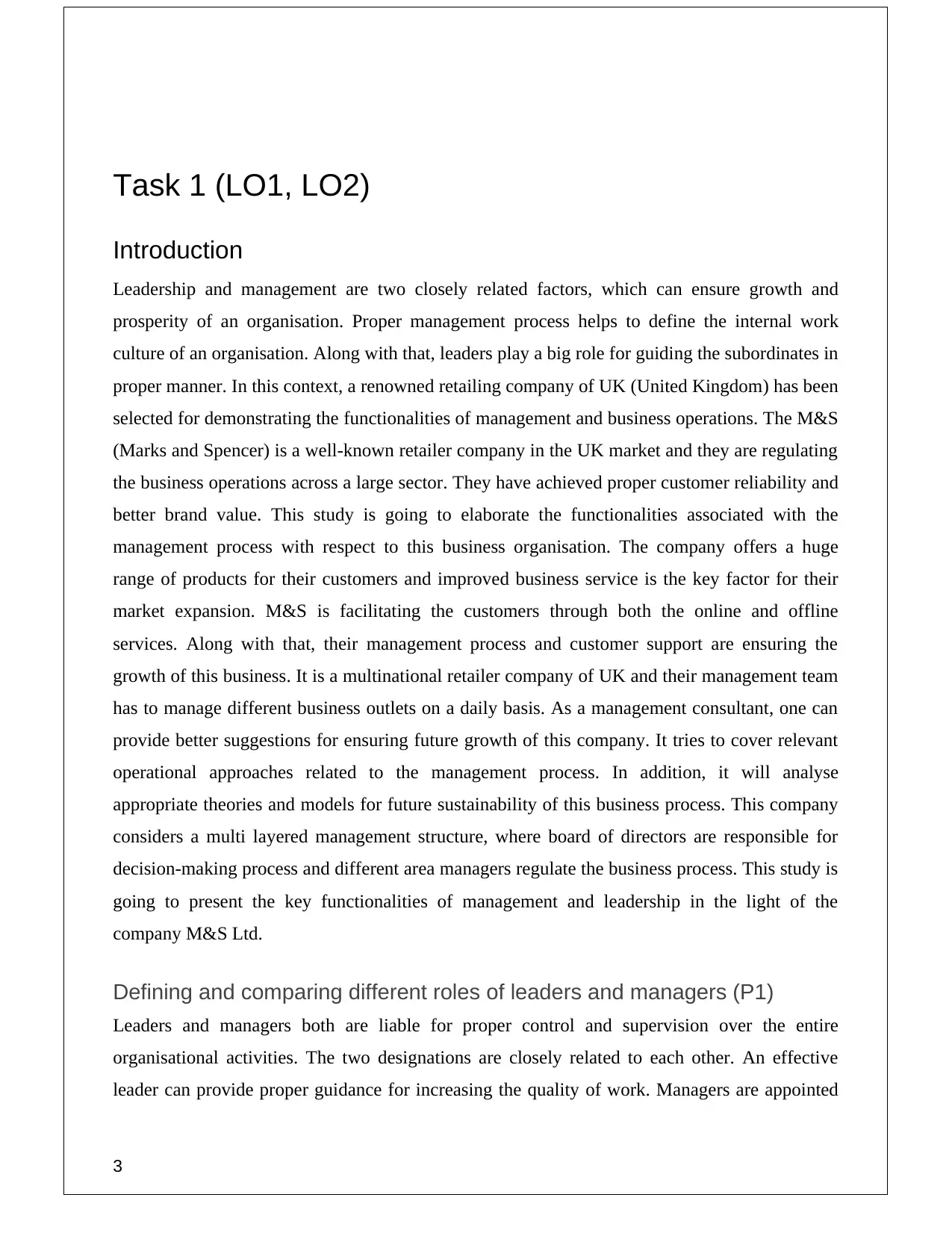
Task 1 (LO1, LO2)
Introduction
Leadership and management are two closely related factors, which can ensure growth and
prosperity of an organisation. Proper management process helps to define the internal work
culture of an organisation. Along with that, leaders play a big role for guiding the subordinates in
proper manner. In this context, a renowned retailing company of UK (United Kingdom) has been
selected for demonstrating the functionalities of management and business operations. The M&S
(Marks and Spencer) is a well-known retailer company in the UK market and they are regulating
the business operations across a large sector. They have achieved proper customer reliability and
better brand value. This study is going to elaborate the functionalities associated with the
management process with respect to this business organisation. The company offers a huge
range of products for their customers and improved business service is the key factor for their
market expansion. M&S is facilitating the customers through both the online and offline
services. Along with that, their management process and customer support are ensuring the
growth of this business. It is a multinational retailer company of UK and their management team
has to manage different business outlets on a daily basis. As a management consultant, one can
provide better suggestions for ensuring future growth of this company. It tries to cover relevant
operational approaches related to the management process. In addition, it will analyse
appropriate theories and models for future sustainability of this business process. This company
considers a multi layered management structure, where board of directors are responsible for
decision-making process and different area managers regulate the business process. This study is
going to present the key functionalities of management and leadership in the light of the
company M&S Ltd.
Defining and comparing different roles of leaders and managers (P1)
Leaders and managers both are liable for proper control and supervision over the entire
organisational activities. The two designations are closely related to each other. An effective
leader can provide proper guidance for increasing the quality of work. Managers are appointed
3
Introduction
Leadership and management are two closely related factors, which can ensure growth and
prosperity of an organisation. Proper management process helps to define the internal work
culture of an organisation. Along with that, leaders play a big role for guiding the subordinates in
proper manner. In this context, a renowned retailing company of UK (United Kingdom) has been
selected for demonstrating the functionalities of management and business operations. The M&S
(Marks and Spencer) is a well-known retailer company in the UK market and they are regulating
the business operations across a large sector. They have achieved proper customer reliability and
better brand value. This study is going to elaborate the functionalities associated with the
management process with respect to this business organisation. The company offers a huge
range of products for their customers and improved business service is the key factor for their
market expansion. M&S is facilitating the customers through both the online and offline
services. Along with that, their management process and customer support are ensuring the
growth of this business. It is a multinational retailer company of UK and their management team
has to manage different business outlets on a daily basis. As a management consultant, one can
provide better suggestions for ensuring future growth of this company. It tries to cover relevant
operational approaches related to the management process. In addition, it will analyse
appropriate theories and models for future sustainability of this business process. This company
considers a multi layered management structure, where board of directors are responsible for
decision-making process and different area managers regulate the business process. This study is
going to present the key functionalities of management and leadership in the light of the
company M&S Ltd.
Defining and comparing different roles of leaders and managers (P1)
Leaders and managers both are liable for proper control and supervision over the entire
organisational activities. The two designations are closely related to each other. An effective
leader can provide proper guidance for increasing the quality of work. Managers are appointed
3
⊘ This is a preview!⊘
Do you want full access?
Subscribe today to unlock all pages.

Trusted by 1+ million students worldwide
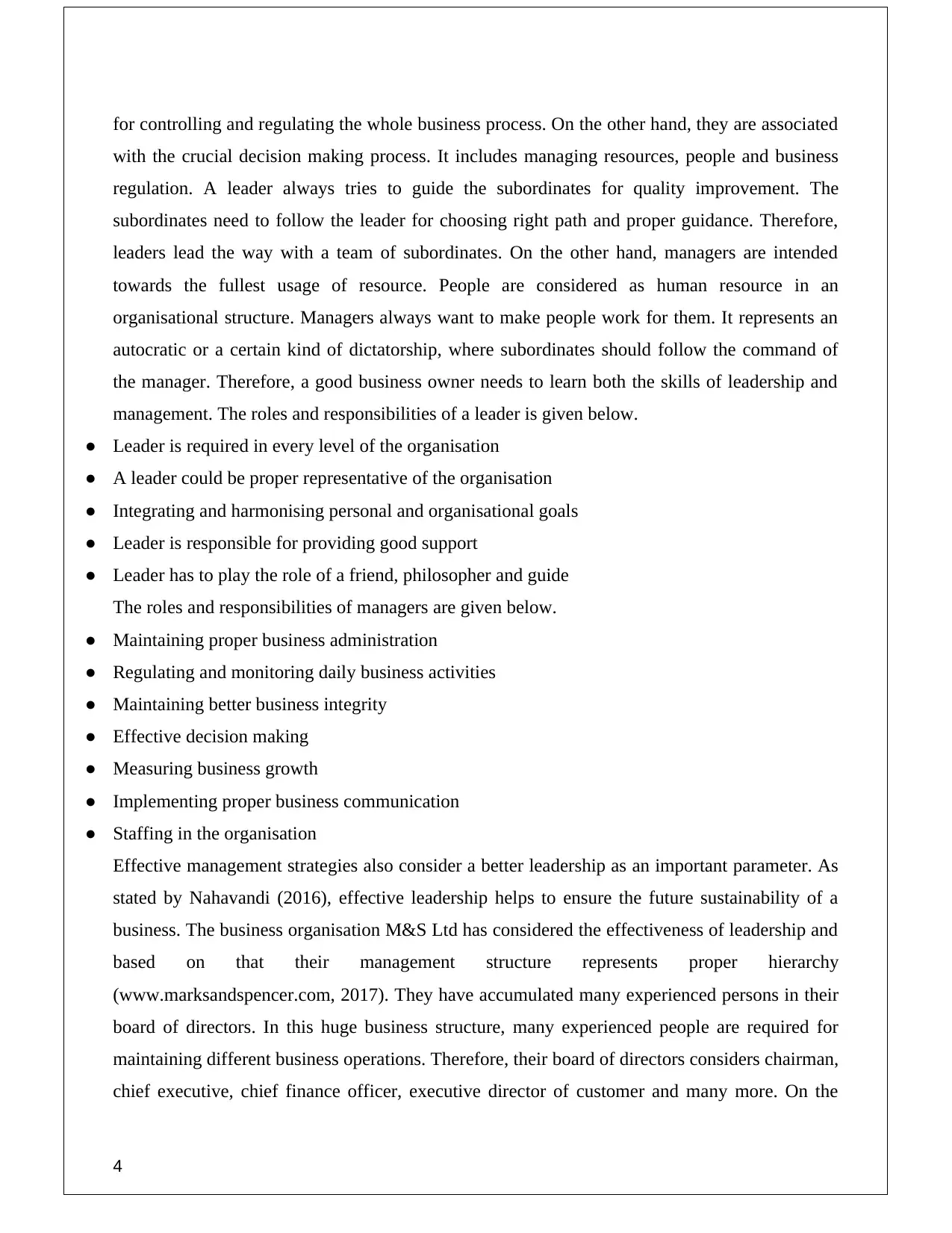
for controlling and regulating the whole business process. On the other hand, they are associated
with the crucial decision making process. It includes managing resources, people and business
regulation. A leader always tries to guide the subordinates for quality improvement. The
subordinates need to follow the leader for choosing right path and proper guidance. Therefore,
leaders lead the way with a team of subordinates. On the other hand, managers are intended
towards the fullest usage of resource. People are considered as human resource in an
organisational structure. Managers always want to make people work for them. It represents an
autocratic or a certain kind of dictatorship, where subordinates should follow the command of
the manager. Therefore, a good business owner needs to learn both the skills of leadership and
management. The roles and responsibilities of a leader is given below.
● Leader is required in every level of the organisation
● A leader could be proper representative of the organisation
● Integrating and harmonising personal and organisational goals
● Leader is responsible for providing good support
● Leader has to play the role of a friend, philosopher and guide
The roles and responsibilities of managers are given below.
● Maintaining proper business administration
● Regulating and monitoring daily business activities
● Maintaining better business integrity
● Effective decision making
● Measuring business growth
● Implementing proper business communication
● Staffing in the organisation
Effective management strategies also consider a better leadership as an important parameter. As
stated by Nahavandi (2016), effective leadership helps to ensure the future sustainability of a
business. The business organisation M&S Ltd has considered the effectiveness of leadership and
based on that their management structure represents proper hierarchy
(www.marksandspencer.com, 2017). They have accumulated many experienced persons in their
board of directors. In this huge business structure, many experienced people are required for
maintaining different business operations. Therefore, their board of directors considers chairman,
chief executive, chief finance officer, executive director of customer and many more. On the
4
with the crucial decision making process. It includes managing resources, people and business
regulation. A leader always tries to guide the subordinates for quality improvement. The
subordinates need to follow the leader for choosing right path and proper guidance. Therefore,
leaders lead the way with a team of subordinates. On the other hand, managers are intended
towards the fullest usage of resource. People are considered as human resource in an
organisational structure. Managers always want to make people work for them. It represents an
autocratic or a certain kind of dictatorship, where subordinates should follow the command of
the manager. Therefore, a good business owner needs to learn both the skills of leadership and
management. The roles and responsibilities of a leader is given below.
● Leader is required in every level of the organisation
● A leader could be proper representative of the organisation
● Integrating and harmonising personal and organisational goals
● Leader is responsible for providing good support
● Leader has to play the role of a friend, philosopher and guide
The roles and responsibilities of managers are given below.
● Maintaining proper business administration
● Regulating and monitoring daily business activities
● Maintaining better business integrity
● Effective decision making
● Measuring business growth
● Implementing proper business communication
● Staffing in the organisation
Effective management strategies also consider a better leadership as an important parameter. As
stated by Nahavandi (2016), effective leadership helps to ensure the future sustainability of a
business. The business organisation M&S Ltd has considered the effectiveness of leadership and
based on that their management structure represents proper hierarchy
(www.marksandspencer.com, 2017). They have accumulated many experienced persons in their
board of directors. In this huge business structure, many experienced people are required for
maintaining different business operations. Therefore, their board of directors considers chairman,
chief executive, chief finance officer, executive director of customer and many more. On the
4
Paraphrase This Document
Need a fresh take? Get an instant paraphrase of this document with our AI Paraphraser
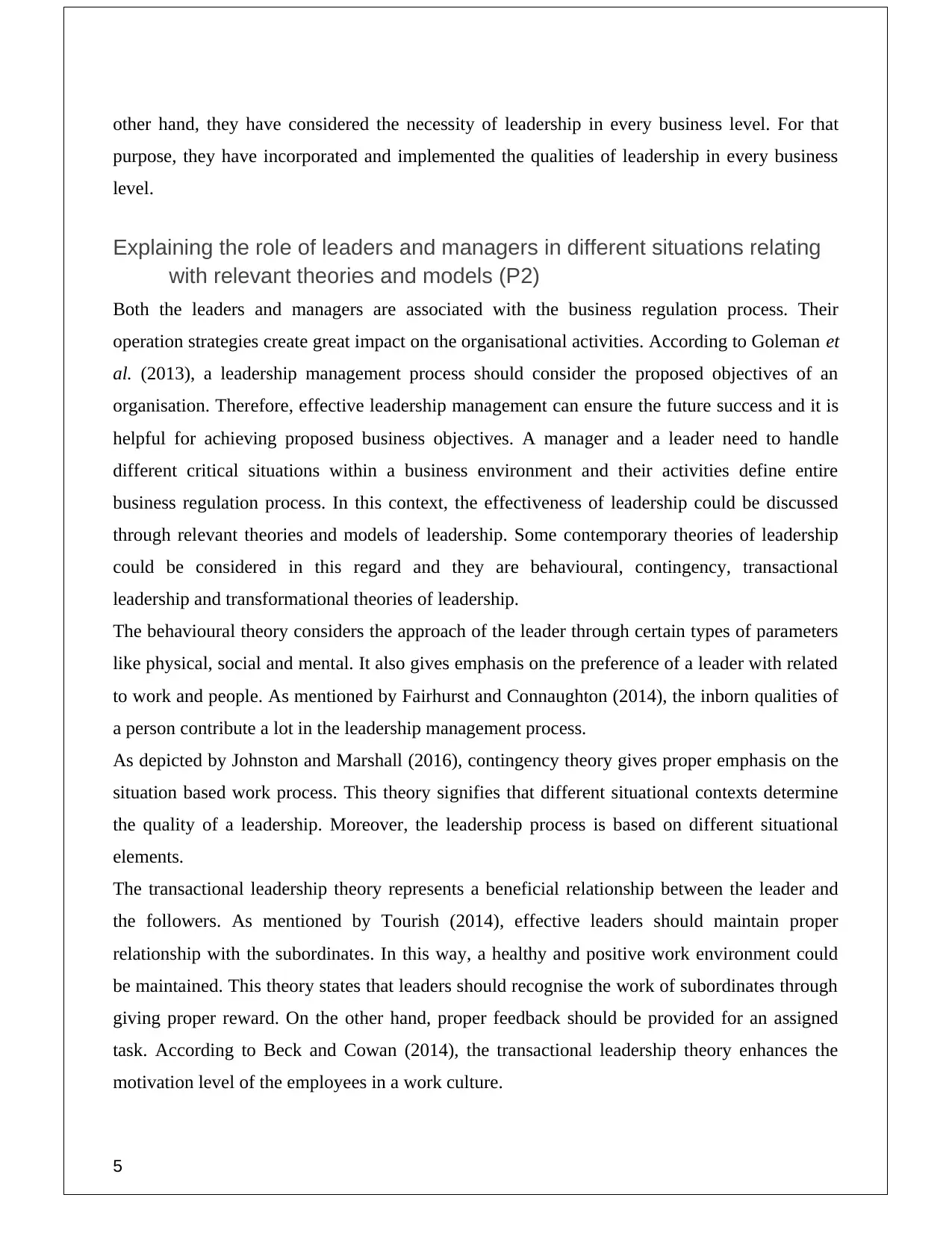
other hand, they have considered the necessity of leadership in every business level. For that
purpose, they have incorporated and implemented the qualities of leadership in every business
level.
Explaining the role of leaders and managers in different situations relating
with relevant theories and models (P2)
Both the leaders and managers are associated with the business regulation process. Their
operation strategies create great impact on the organisational activities. According to Goleman et
al. (2013), a leadership management process should consider the proposed objectives of an
organisation. Therefore, effective leadership management can ensure the future success and it is
helpful for achieving proposed business objectives. A manager and a leader need to handle
different critical situations within a business environment and their activities define entire
business regulation process. In this context, the effectiveness of leadership could be discussed
through relevant theories and models of leadership. Some contemporary theories of leadership
could be considered in this regard and they are behavioural, contingency, transactional
leadership and transformational theories of leadership.
The behavioural theory considers the approach of the leader through certain types of parameters
like physical, social and mental. It also gives emphasis on the preference of a leader with related
to work and people. As mentioned by Fairhurst and Connaughton (2014), the inborn qualities of
a person contribute a lot in the leadership management process.
As depicted by Johnston and Marshall (2016), contingency theory gives proper emphasis on the
situation based work process. This theory signifies that different situational contexts determine
the quality of a leadership. Moreover, the leadership process is based on different situational
elements.
The transactional leadership theory represents a beneficial relationship between the leader and
the followers. As mentioned by Tourish (2014), effective leaders should maintain proper
relationship with the subordinates. In this way, a healthy and positive work environment could
be maintained. This theory states that leaders should recognise the work of subordinates through
giving proper reward. On the other hand, proper feedback should be provided for an assigned
task. According to Beck and Cowan (2014), the transactional leadership theory enhances the
motivation level of the employees in a work culture.
5
purpose, they have incorporated and implemented the qualities of leadership in every business
level.
Explaining the role of leaders and managers in different situations relating
with relevant theories and models (P2)
Both the leaders and managers are associated with the business regulation process. Their
operation strategies create great impact on the organisational activities. According to Goleman et
al. (2013), a leadership management process should consider the proposed objectives of an
organisation. Therefore, effective leadership management can ensure the future success and it is
helpful for achieving proposed business objectives. A manager and a leader need to handle
different critical situations within a business environment and their activities define entire
business regulation process. In this context, the effectiveness of leadership could be discussed
through relevant theories and models of leadership. Some contemporary theories of leadership
could be considered in this regard and they are behavioural, contingency, transactional
leadership and transformational theories of leadership.
The behavioural theory considers the approach of the leader through certain types of parameters
like physical, social and mental. It also gives emphasis on the preference of a leader with related
to work and people. As mentioned by Fairhurst and Connaughton (2014), the inborn qualities of
a person contribute a lot in the leadership management process.
As depicted by Johnston and Marshall (2016), contingency theory gives proper emphasis on the
situation based work process. This theory signifies that different situational contexts determine
the quality of a leadership. Moreover, the leadership process is based on different situational
elements.
The transactional leadership theory represents a beneficial relationship between the leader and
the followers. As mentioned by Tourish (2014), effective leaders should maintain proper
relationship with the subordinates. In this way, a healthy and positive work environment could
be maintained. This theory states that leaders should recognise the work of subordinates through
giving proper reward. On the other hand, proper feedback should be provided for an assigned
task. According to Beck and Cowan (2014), the transactional leadership theory enhances the
motivation level of the employees in a work culture.
5
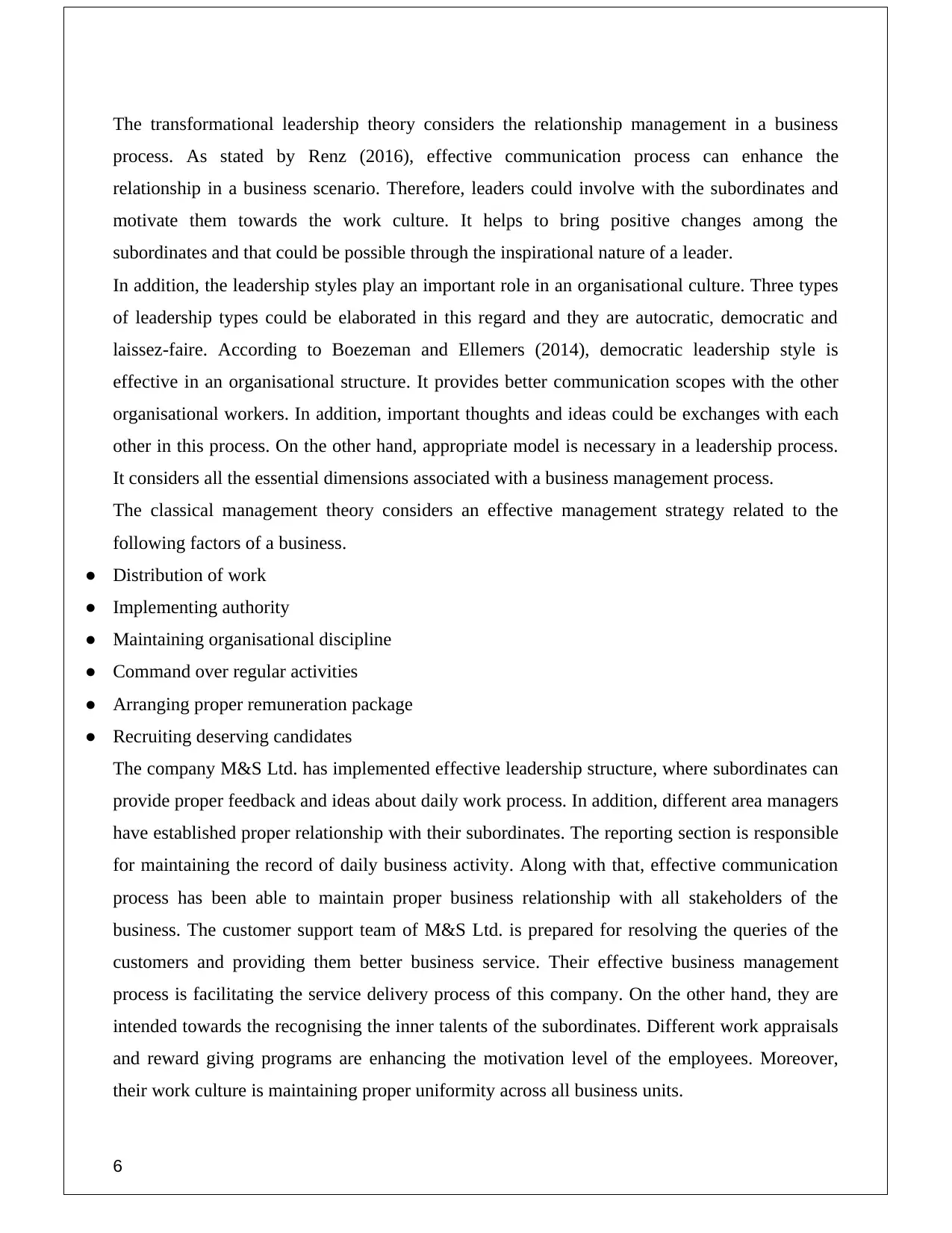
The transformational leadership theory considers the relationship management in a business
process. As stated by Renz (2016), effective communication process can enhance the
relationship in a business scenario. Therefore, leaders could involve with the subordinates and
motivate them towards the work culture. It helps to bring positive changes among the
subordinates and that could be possible through the inspirational nature of a leader.
In addition, the leadership styles play an important role in an organisational culture. Three types
of leadership types could be elaborated in this regard and they are autocratic, democratic and
laissez-faire. According to Boezeman and Ellemers (2014), democratic leadership style is
effective in an organisational structure. It provides better communication scopes with the other
organisational workers. In addition, important thoughts and ideas could be exchanges with each
other in this process. On the other hand, appropriate model is necessary in a leadership process.
It considers all the essential dimensions associated with a business management process.
The classical management theory considers an effective management strategy related to the
following factors of a business.
● Distribution of work
● Implementing authority
● Maintaining organisational discipline
● Command over regular activities
● Arranging proper remuneration package
● Recruiting deserving candidates
The company M&S Ltd. has implemented effective leadership structure, where subordinates can
provide proper feedback and ideas about daily work process. In addition, different area managers
have established proper relationship with their subordinates. The reporting section is responsible
for maintaining the record of daily business activity. Along with that, effective communication
process has been able to maintain proper business relationship with all stakeholders of the
business. The customer support team of M&S Ltd. is prepared for resolving the queries of the
customers and providing them better business service. Their effective business management
process is facilitating the service delivery process of this company. On the other hand, they are
intended towards the recognising the inner talents of the subordinates. Different work appraisals
and reward giving programs are enhancing the motivation level of the employees. Moreover,
their work culture is maintaining proper uniformity across all business units.
6
process. As stated by Renz (2016), effective communication process can enhance the
relationship in a business scenario. Therefore, leaders could involve with the subordinates and
motivate them towards the work culture. It helps to bring positive changes among the
subordinates and that could be possible through the inspirational nature of a leader.
In addition, the leadership styles play an important role in an organisational culture. Three types
of leadership types could be elaborated in this regard and they are autocratic, democratic and
laissez-faire. According to Boezeman and Ellemers (2014), democratic leadership style is
effective in an organisational structure. It provides better communication scopes with the other
organisational workers. In addition, important thoughts and ideas could be exchanges with each
other in this process. On the other hand, appropriate model is necessary in a leadership process.
It considers all the essential dimensions associated with a business management process.
The classical management theory considers an effective management strategy related to the
following factors of a business.
● Distribution of work
● Implementing authority
● Maintaining organisational discipline
● Command over regular activities
● Arranging proper remuneration package
● Recruiting deserving candidates
The company M&S Ltd. has implemented effective leadership structure, where subordinates can
provide proper feedback and ideas about daily work process. In addition, different area managers
have established proper relationship with their subordinates. The reporting section is responsible
for maintaining the record of daily business activity. Along with that, effective communication
process has been able to maintain proper business relationship with all stakeholders of the
business. The customer support team of M&S Ltd. is prepared for resolving the queries of the
customers and providing them better business service. Their effective business management
process is facilitating the service delivery process of this company. On the other hand, they are
intended towards the recognising the inner talents of the subordinates. Different work appraisals
and reward giving programs are enhancing the motivation level of the employees. Moreover,
their work culture is maintaining proper uniformity across all business units.
6
⊘ This is a preview!⊘
Do you want full access?
Subscribe today to unlock all pages.

Trusted by 1+ million students worldwide
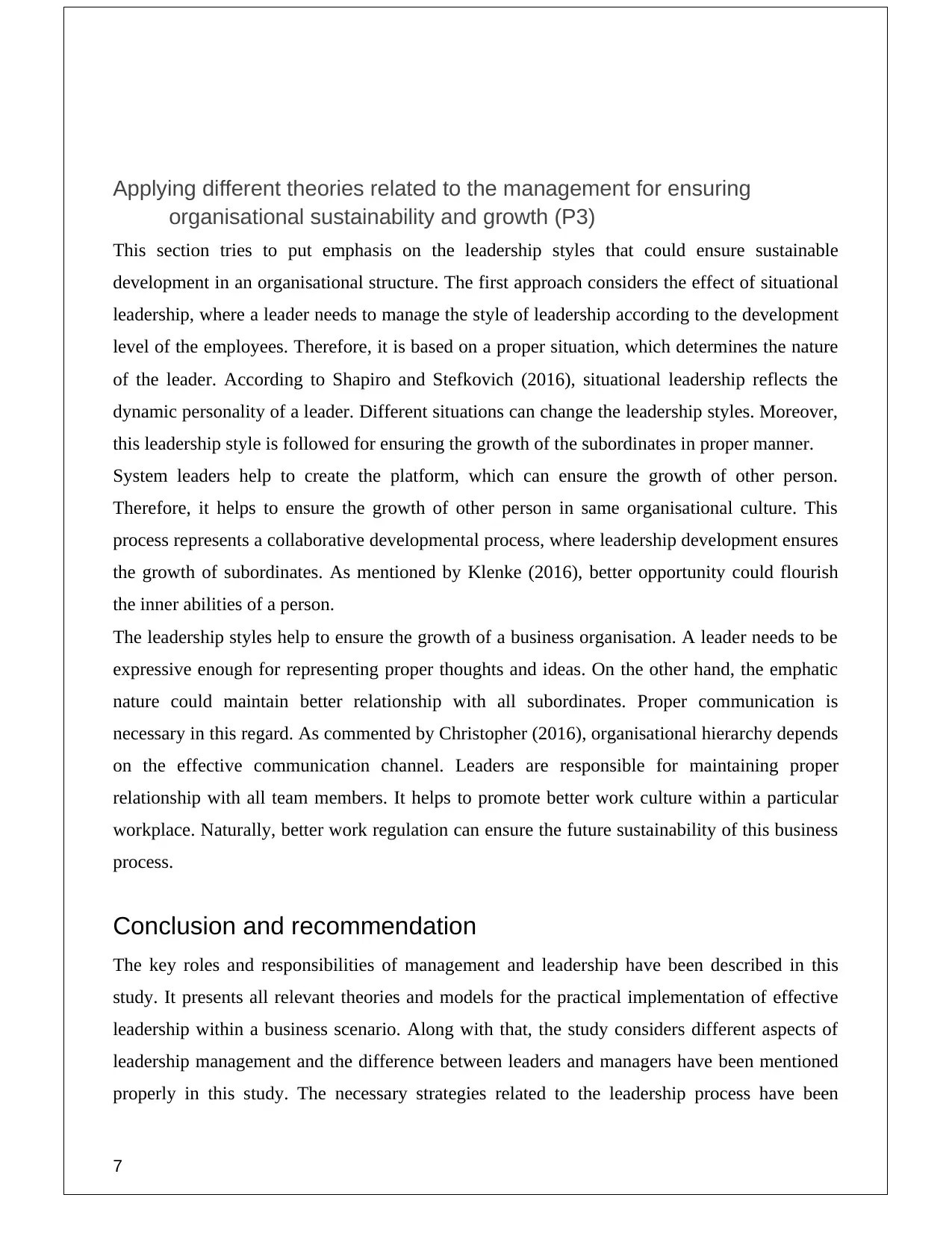
Applying different theories related to the management for ensuring
organisational sustainability and growth (P3)
This section tries to put emphasis on the leadership styles that could ensure sustainable
development in an organisational structure. The first approach considers the effect of situational
leadership, where a leader needs to manage the style of leadership according to the development
level of the employees. Therefore, it is based on a proper situation, which determines the nature
of the leader. According to Shapiro and Stefkovich (2016), situational leadership reflects the
dynamic personality of a leader. Different situations can change the leadership styles. Moreover,
this leadership style is followed for ensuring the growth of the subordinates in proper manner.
System leaders help to create the platform, which can ensure the growth of other person.
Therefore, it helps to ensure the growth of other person in same organisational culture. This
process represents a collaborative developmental process, where leadership development ensures
the growth of subordinates. As mentioned by Klenke (2016), better opportunity could flourish
the inner abilities of a person.
The leadership styles help to ensure the growth of a business organisation. A leader needs to be
expressive enough for representing proper thoughts and ideas. On the other hand, the emphatic
nature could maintain better relationship with all subordinates. Proper communication is
necessary in this regard. As commented by Christopher (2016), organisational hierarchy depends
on the effective communication channel. Leaders are responsible for maintaining proper
relationship with all team members. It helps to promote better work culture within a particular
workplace. Naturally, better work regulation can ensure the future sustainability of this business
process.
Conclusion and recommendation
The key roles and responsibilities of management and leadership have been described in this
study. It presents all relevant theories and models for the practical implementation of effective
leadership within a business scenario. Along with that, the study considers different aspects of
leadership management and the difference between leaders and managers have been mentioned
properly in this study. The necessary strategies related to the leadership process have been
7
organisational sustainability and growth (P3)
This section tries to put emphasis on the leadership styles that could ensure sustainable
development in an organisational structure. The first approach considers the effect of situational
leadership, where a leader needs to manage the style of leadership according to the development
level of the employees. Therefore, it is based on a proper situation, which determines the nature
of the leader. According to Shapiro and Stefkovich (2016), situational leadership reflects the
dynamic personality of a leader. Different situations can change the leadership styles. Moreover,
this leadership style is followed for ensuring the growth of the subordinates in proper manner.
System leaders help to create the platform, which can ensure the growth of other person.
Therefore, it helps to ensure the growth of other person in same organisational culture. This
process represents a collaborative developmental process, where leadership development ensures
the growth of subordinates. As mentioned by Klenke (2016), better opportunity could flourish
the inner abilities of a person.
The leadership styles help to ensure the growth of a business organisation. A leader needs to be
expressive enough for representing proper thoughts and ideas. On the other hand, the emphatic
nature could maintain better relationship with all subordinates. Proper communication is
necessary in this regard. As commented by Christopher (2016), organisational hierarchy depends
on the effective communication channel. Leaders are responsible for maintaining proper
relationship with all team members. It helps to promote better work culture within a particular
workplace. Naturally, better work regulation can ensure the future sustainability of this business
process.
Conclusion and recommendation
The key roles and responsibilities of management and leadership have been described in this
study. It presents all relevant theories and models for the practical implementation of effective
leadership within a business scenario. Along with that, the study considers different aspects of
leadership management and the difference between leaders and managers have been mentioned
properly in this study. The necessary strategies related to the leadership process have been
7
Paraphrase This Document
Need a fresh take? Get an instant paraphrase of this document with our AI Paraphraser
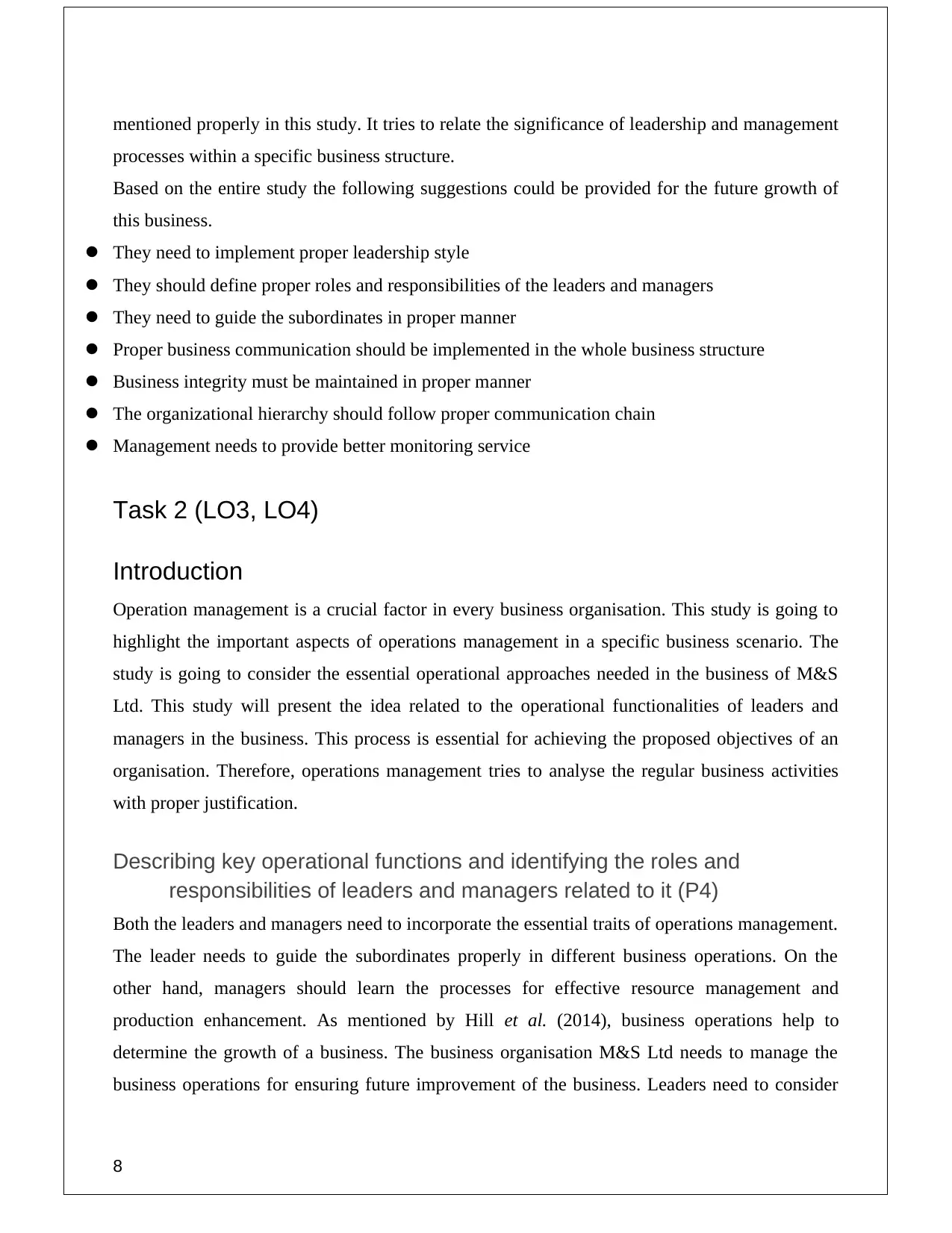
mentioned properly in this study. It tries to relate the significance of leadership and management
processes within a specific business structure.
Based on the entire study the following suggestions could be provided for the future growth of
this business.
They need to implement proper leadership style
They should define proper roles and responsibilities of the leaders and managers
They need to guide the subordinates in proper manner
Proper business communication should be implemented in the whole business structure
Business integrity must be maintained in proper manner
The organizational hierarchy should follow proper communication chain
Management needs to provide better monitoring service
Task 2 (LO3, LO4)
Introduction
Operation management is a crucial factor in every business organisation. This study is going to
highlight the important aspects of operations management in a specific business scenario. The
study is going to consider the essential operational approaches needed in the business of M&S
Ltd. This study will present the idea related to the operational functionalities of leaders and
managers in the business. This process is essential for achieving the proposed objectives of an
organisation. Therefore, operations management tries to analyse the regular business activities
with proper justification.
Describing key operational functions and identifying the roles and
responsibilities of leaders and managers related to it (P4)
Both the leaders and managers need to incorporate the essential traits of operations management.
The leader needs to guide the subordinates properly in different business operations. On the
other hand, managers should learn the processes for effective resource management and
production enhancement. As mentioned by Hill et al. (2014), business operations help to
determine the growth of a business. The business organisation M&S Ltd needs to manage the
business operations for ensuring future improvement of the business. Leaders need to consider
8
processes within a specific business structure.
Based on the entire study the following suggestions could be provided for the future growth of
this business.
They need to implement proper leadership style
They should define proper roles and responsibilities of the leaders and managers
They need to guide the subordinates in proper manner
Proper business communication should be implemented in the whole business structure
Business integrity must be maintained in proper manner
The organizational hierarchy should follow proper communication chain
Management needs to provide better monitoring service
Task 2 (LO3, LO4)
Introduction
Operation management is a crucial factor in every business organisation. This study is going to
highlight the important aspects of operations management in a specific business scenario. The
study is going to consider the essential operational approaches needed in the business of M&S
Ltd. This study will present the idea related to the operational functionalities of leaders and
managers in the business. This process is essential for achieving the proposed objectives of an
organisation. Therefore, operations management tries to analyse the regular business activities
with proper justification.
Describing key operational functions and identifying the roles and
responsibilities of leaders and managers related to it (P4)
Both the leaders and managers need to incorporate the essential traits of operations management.
The leader needs to guide the subordinates properly in different business operations. On the
other hand, managers should learn the processes for effective resource management and
production enhancement. As mentioned by Hill et al. (2014), business operations help to
determine the growth of a business. The business organisation M&S Ltd needs to manage the
business operations for ensuring future improvement of the business. Leaders need to consider
8
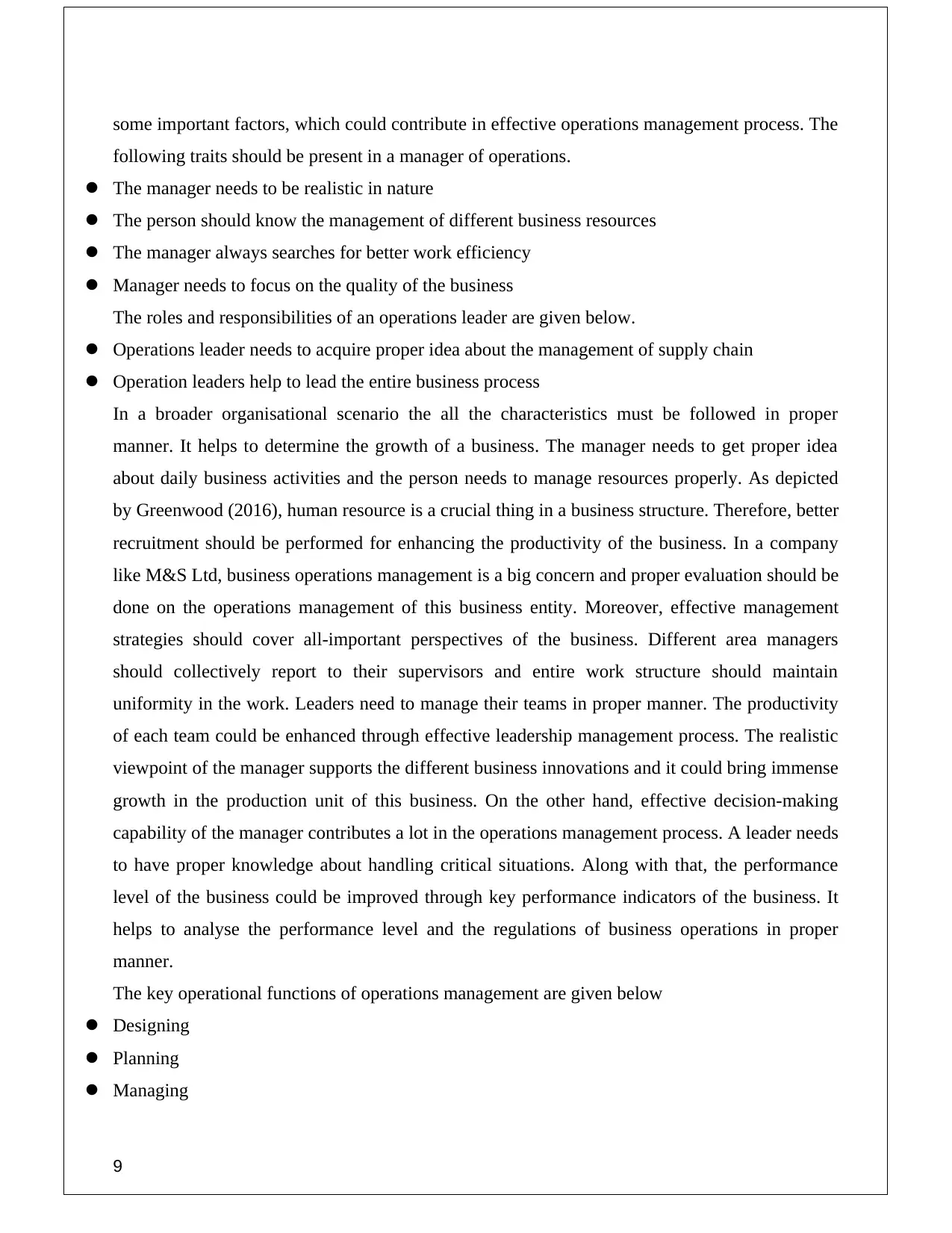
some important factors, which could contribute in effective operations management process. The
following traits should be present in a manager of operations.
The manager needs to be realistic in nature
The person should know the management of different business resources
The manager always searches for better work efficiency
Manager needs to focus on the quality of the business
The roles and responsibilities of an operations leader are given below.
Operations leader needs to acquire proper idea about the management of supply chain
Operation leaders help to lead the entire business process
In a broader organisational scenario the all the characteristics must be followed in proper
manner. It helps to determine the growth of a business. The manager needs to get proper idea
about daily business activities and the person needs to manage resources properly. As depicted
by Greenwood (2016), human resource is a crucial thing in a business structure. Therefore, better
recruitment should be performed for enhancing the productivity of the business. In a company
like M&S Ltd, business operations management is a big concern and proper evaluation should be
done on the operations management of this business entity. Moreover, effective management
strategies should cover all-important perspectives of the business. Different area managers
should collectively report to their supervisors and entire work structure should maintain
uniformity in the work. Leaders need to manage their teams in proper manner. The productivity
of each team could be enhanced through effective leadership management process. The realistic
viewpoint of the manager supports the different business innovations and it could bring immense
growth in the production unit of this business. On the other hand, effective decision-making
capability of the manager contributes a lot in the operations management process. A leader needs
to have proper knowledge about handling critical situations. Along with that, the performance
level of the business could be improved through key performance indicators of the business. It
helps to analyse the performance level and the regulations of business operations in proper
manner.
The key operational functions of operations management are given below
Designing
Planning
Managing
9
following traits should be present in a manager of operations.
The manager needs to be realistic in nature
The person should know the management of different business resources
The manager always searches for better work efficiency
Manager needs to focus on the quality of the business
The roles and responsibilities of an operations leader are given below.
Operations leader needs to acquire proper idea about the management of supply chain
Operation leaders help to lead the entire business process
In a broader organisational scenario the all the characteristics must be followed in proper
manner. It helps to determine the growth of a business. The manager needs to get proper idea
about daily business activities and the person needs to manage resources properly. As depicted
by Greenwood (2016), human resource is a crucial thing in a business structure. Therefore, better
recruitment should be performed for enhancing the productivity of the business. In a company
like M&S Ltd, business operations management is a big concern and proper evaluation should be
done on the operations management of this business entity. Moreover, effective management
strategies should cover all-important perspectives of the business. Different area managers
should collectively report to their supervisors and entire work structure should maintain
uniformity in the work. Leaders need to manage their teams in proper manner. The productivity
of each team could be enhanced through effective leadership management process. The realistic
viewpoint of the manager supports the different business innovations and it could bring immense
growth in the production unit of this business. On the other hand, effective decision-making
capability of the manager contributes a lot in the operations management process. A leader needs
to have proper knowledge about handling critical situations. Along with that, the performance
level of the business could be improved through key performance indicators of the business. It
helps to analyse the performance level and the regulations of business operations in proper
manner.
The key operational functions of operations management are given below
Designing
Planning
Managing
9
⊘ This is a preview!⊘
Do you want full access?
Subscribe today to unlock all pages.

Trusted by 1+ million students worldwide
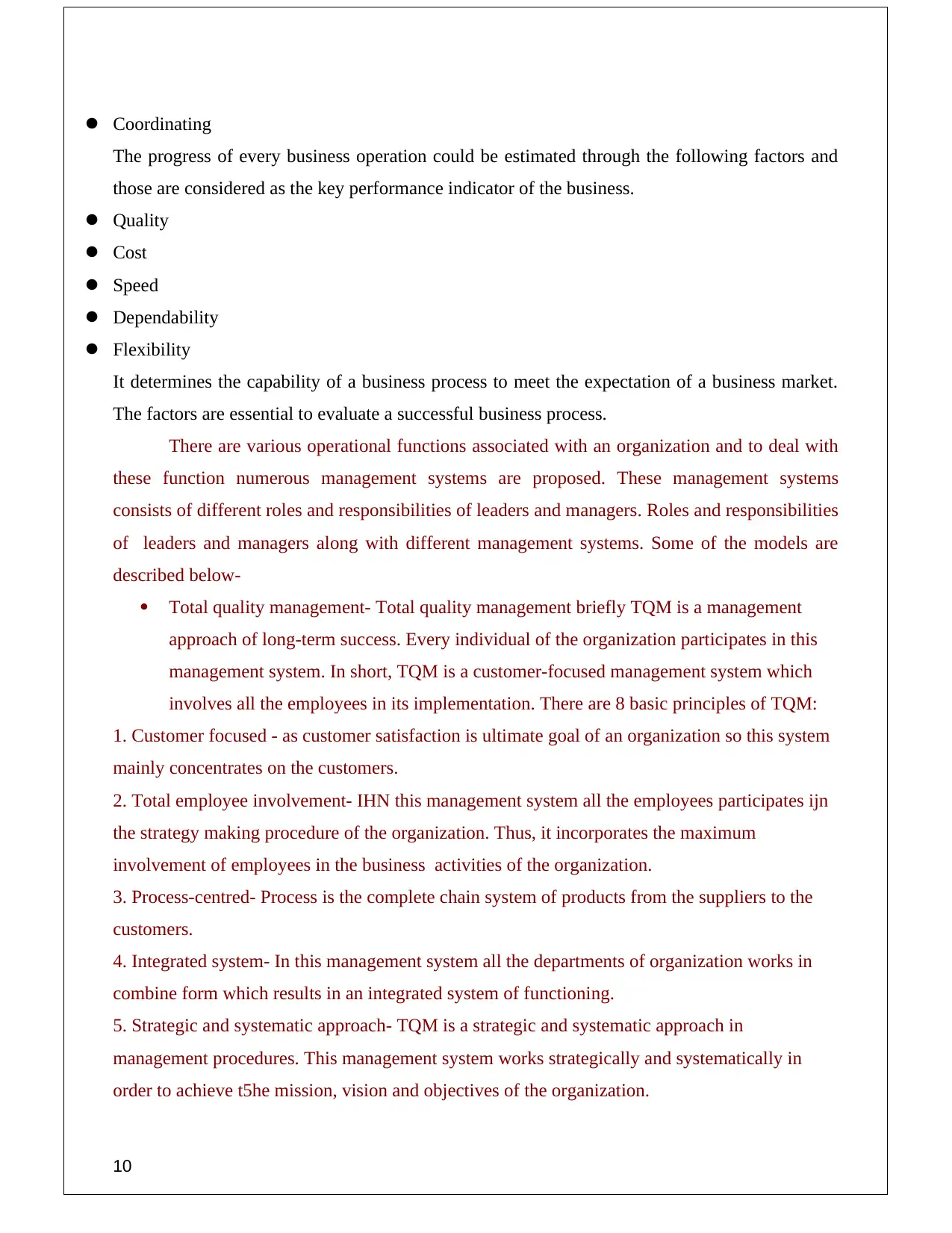
Coordinating
The progress of every business operation could be estimated through the following factors and
those are considered as the key performance indicator of the business.
Quality
Cost
Speed
Dependability
Flexibility
It determines the capability of a business process to meet the expectation of a business market.
The factors are essential to evaluate a successful business process.
There are various operational functions associated with an organization and to deal with
these function numerous management systems are proposed. These management systems
consists of different roles and responsibilities of leaders and managers. Roles and responsibilities
of leaders and managers along with different management systems. Some of the models are
described below-
Total quality management- Total quality management briefly TQM is a management
approach of long-term success. Every individual of the organization participates in this
management system. In short, TQM is a customer-focused management system which
involves all the employees in its implementation. There are 8 basic principles of TQM:
1. Customer focused - as customer satisfaction is ultimate goal of an organization so this system
mainly concentrates on the customers.
2. Total employee involvement- IHN this management system all the employees participates ijn
the strategy making procedure of the organization. Thus, it incorporates the maximum
involvement of employees in the business activities of the organization.
3. Process-centred- Process is the complete chain system of products from the suppliers to the
customers.
4. Integrated system- In this management system all the departments of organization works in
combine form which results in an integrated system of functioning.
5. Strategic and systematic approach- TQM is a strategic and systematic approach in
management procedures. This management system works strategically and systematically in
order to achieve t5he mission, vision and objectives of the organization.
10
The progress of every business operation could be estimated through the following factors and
those are considered as the key performance indicator of the business.
Quality
Cost
Speed
Dependability
Flexibility
It determines the capability of a business process to meet the expectation of a business market.
The factors are essential to evaluate a successful business process.
There are various operational functions associated with an organization and to deal with
these function numerous management systems are proposed. These management systems
consists of different roles and responsibilities of leaders and managers. Roles and responsibilities
of leaders and managers along with different management systems. Some of the models are
described below-
Total quality management- Total quality management briefly TQM is a management
approach of long-term success. Every individual of the organization participates in this
management system. In short, TQM is a customer-focused management system which
involves all the employees in its implementation. There are 8 basic principles of TQM:
1. Customer focused - as customer satisfaction is ultimate goal of an organization so this system
mainly concentrates on the customers.
2. Total employee involvement- IHN this management system all the employees participates ijn
the strategy making procedure of the organization. Thus, it incorporates the maximum
involvement of employees in the business activities of the organization.
3. Process-centred- Process is the complete chain system of products from the suppliers to the
customers.
4. Integrated system- In this management system all the departments of organization works in
combine form which results in an integrated system of functioning.
5. Strategic and systematic approach- TQM is a strategic and systematic approach in
management procedures. This management system works strategically and systematically in
order to achieve t5he mission, vision and objectives of the organization.
10
Paraphrase This Document
Need a fresh take? Get an instant paraphrase of this document with our AI Paraphraser
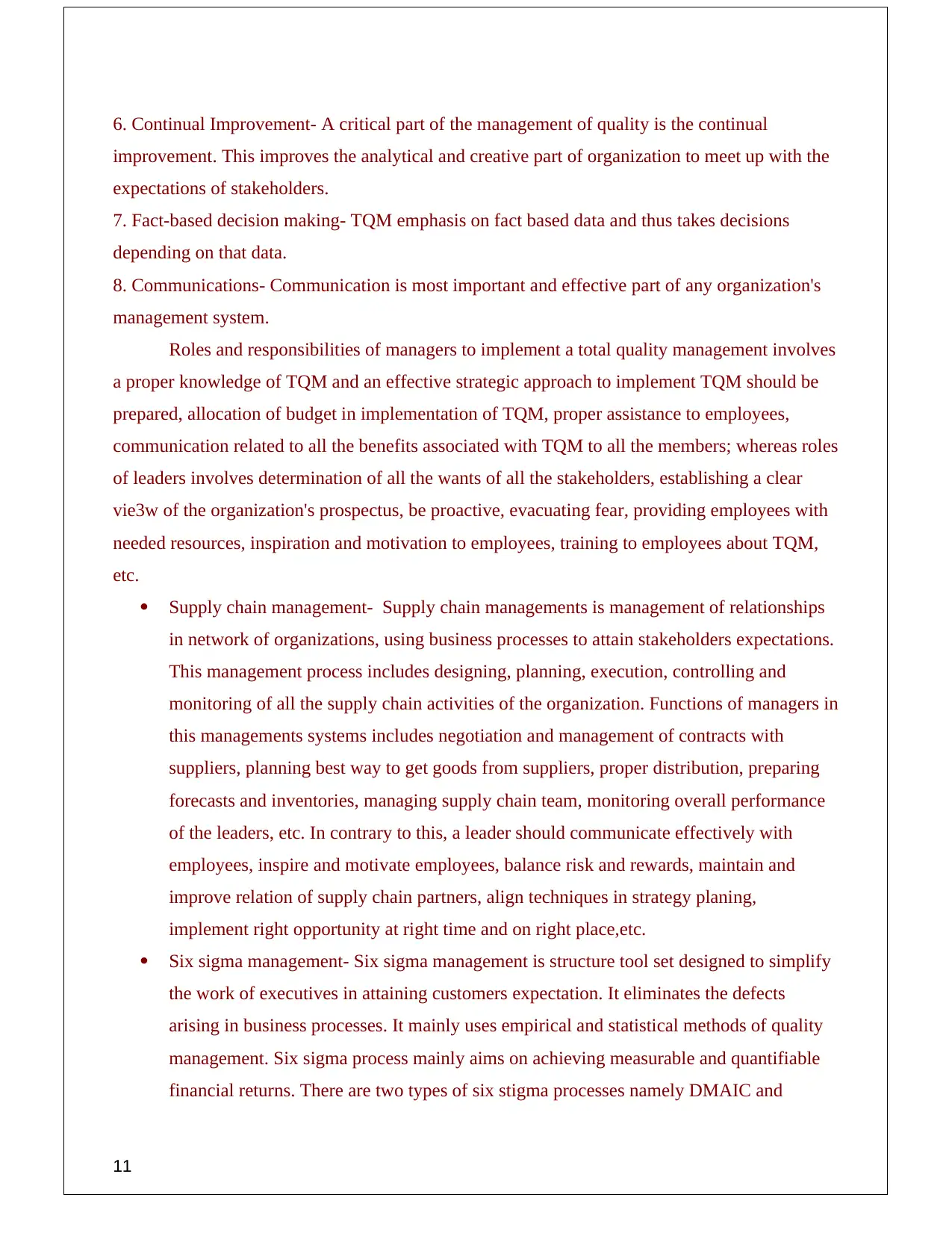
6. Continual Improvement- A critical part of the management of quality is the continual
improvement. This improves the analytical and creative part of organization to meet up with the
expectations of stakeholders.
7. Fact-based decision making- TQM emphasis on fact based data and thus takes decisions
depending on that data.
8. Communications- Communication is most important and effective part of any organization's
management system.
Roles and responsibilities of managers to implement a total quality management involves
a proper knowledge of TQM and an effective strategic approach to implement TQM should be
prepared, allocation of budget in implementation of TQM, proper assistance to employees,
communication related to all the benefits associated with TQM to all the members; whereas roles
of leaders involves determination of all the wants of all the stakeholders, establishing a clear
vie3w of the organization's prospectus, be proactive, evacuating fear, providing employees with
needed resources, inspiration and motivation to employees, training to employees about TQM,
etc.
Supply chain management- Supply chain managements is management of relationships
in network of organizations, using business processes to attain stakeholders expectations.
This management process includes designing, planning, execution, controlling and
monitoring of all the supply chain activities of the organization. Functions of managers in
this managements systems includes negotiation and management of contracts with
suppliers, planning best way to get goods from suppliers, proper distribution, preparing
forecasts and inventories, managing supply chain team, monitoring overall performance
of the leaders, etc. In contrary to this, a leader should communicate effectively with
employees, inspire and motivate employees, balance risk and rewards, maintain and
improve relation of supply chain partners, align techniques in strategy planing,
implement right opportunity at right time and on right place,etc.
Six sigma management- Six sigma management is structure tool set designed to simplify
the work of executives in attaining customers expectation. It eliminates the defects
arising in business processes. It mainly uses empirical and statistical methods of quality
management. Six sigma process mainly aims on achieving measurable and quantifiable
financial returns. There are two types of six stigma processes namely DMAIC and
11
improvement. This improves the analytical and creative part of organization to meet up with the
expectations of stakeholders.
7. Fact-based decision making- TQM emphasis on fact based data and thus takes decisions
depending on that data.
8. Communications- Communication is most important and effective part of any organization's
management system.
Roles and responsibilities of managers to implement a total quality management involves
a proper knowledge of TQM and an effective strategic approach to implement TQM should be
prepared, allocation of budget in implementation of TQM, proper assistance to employees,
communication related to all the benefits associated with TQM to all the members; whereas roles
of leaders involves determination of all the wants of all the stakeholders, establishing a clear
vie3w of the organization's prospectus, be proactive, evacuating fear, providing employees with
needed resources, inspiration and motivation to employees, training to employees about TQM,
etc.
Supply chain management- Supply chain managements is management of relationships
in network of organizations, using business processes to attain stakeholders expectations.
This management process includes designing, planning, execution, controlling and
monitoring of all the supply chain activities of the organization. Functions of managers in
this managements systems includes negotiation and management of contracts with
suppliers, planning best way to get goods from suppliers, proper distribution, preparing
forecasts and inventories, managing supply chain team, monitoring overall performance
of the leaders, etc. In contrary to this, a leader should communicate effectively with
employees, inspire and motivate employees, balance risk and rewards, maintain and
improve relation of supply chain partners, align techniques in strategy planing,
implement right opportunity at right time and on right place,etc.
Six sigma management- Six sigma management is structure tool set designed to simplify
the work of executives in attaining customers expectation. It eliminates the defects
arising in business processes. It mainly uses empirical and statistical methods of quality
management. Six sigma process mainly aims on achieving measurable and quantifiable
financial returns. There are two types of six stigma processes namely DMAIC and
11
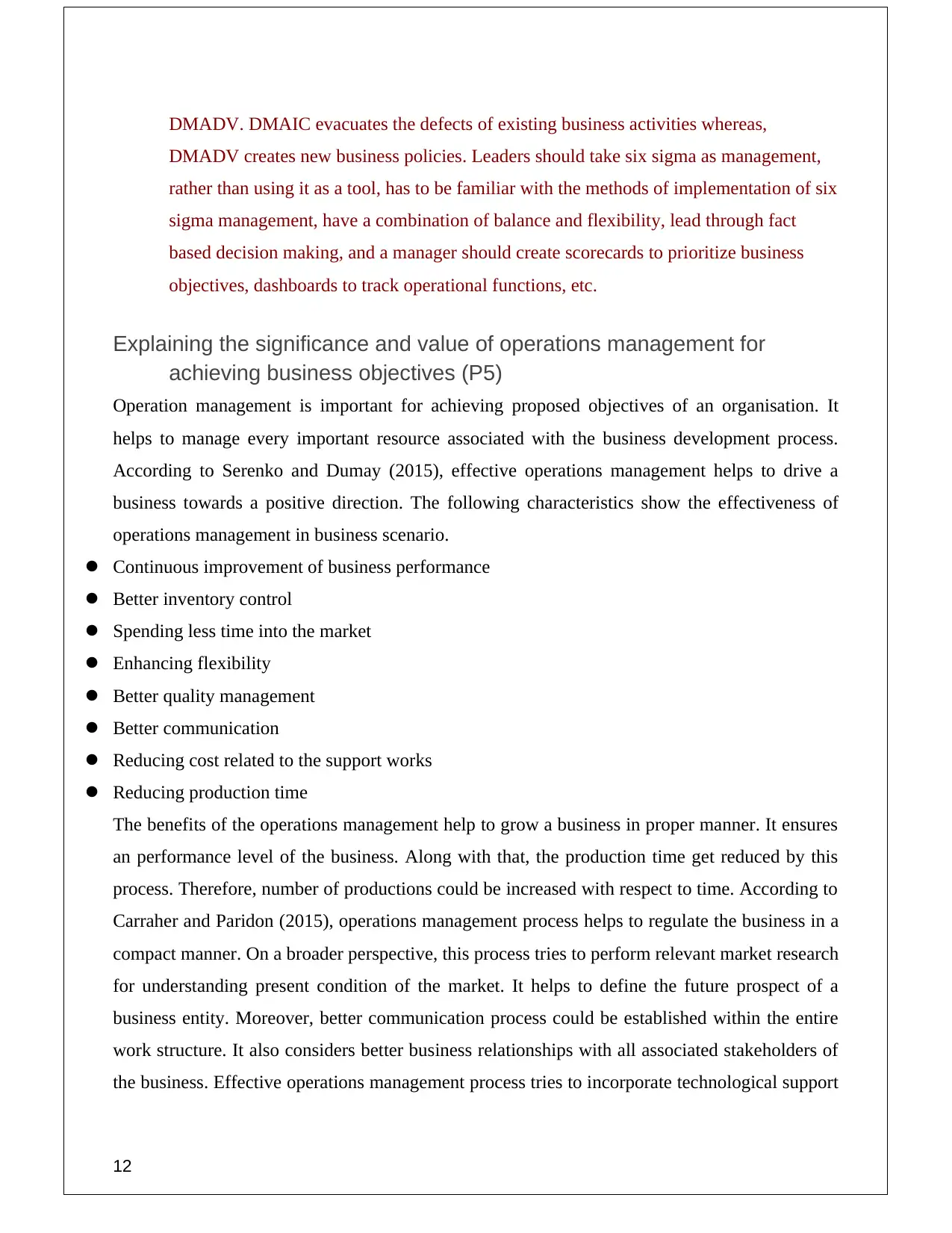
DMADV. DMAIC evacuates the defects of existing business activities whereas,
DMADV creates new business policies. Leaders should take six sigma as management,
rather than using it as a tool, has to be familiar with the methods of implementation of six
sigma management, have a combination of balance and flexibility, lead through fact
based decision making, and a manager should create scorecards to prioritize business
objectives, dashboards to track operational functions, etc.
Explaining the significance and value of operations management for
achieving business objectives (P5)
Operation management is important for achieving proposed objectives of an organisation. It
helps to manage every important resource associated with the business development process.
According to Serenko and Dumay (2015), effective operations management helps to drive a
business towards a positive direction. The following characteristics show the effectiveness of
operations management in business scenario.
Continuous improvement of business performance
Better inventory control
Spending less time into the market
Enhancing flexibility
Better quality management
Better communication
Reducing cost related to the support works
Reducing production time
The benefits of the operations management help to grow a business in proper manner. It ensures
an performance level of the business. Along with that, the production time get reduced by this
process. Therefore, number of productions could be increased with respect to time. According to
Carraher and Paridon (2015), operations management process helps to regulate the business in a
compact manner. On a broader perspective, this process tries to perform relevant market research
for understanding present condition of the market. It helps to define the future prospect of a
business entity. Moreover, better communication process could be established within the entire
work structure. It also considers better business relationships with all associated stakeholders of
the business. Effective operations management process tries to incorporate technological support
12
DMADV creates new business policies. Leaders should take six sigma as management,
rather than using it as a tool, has to be familiar with the methods of implementation of six
sigma management, have a combination of balance and flexibility, lead through fact
based decision making, and a manager should create scorecards to prioritize business
objectives, dashboards to track operational functions, etc.
Explaining the significance and value of operations management for
achieving business objectives (P5)
Operation management is important for achieving proposed objectives of an organisation. It
helps to manage every important resource associated with the business development process.
According to Serenko and Dumay (2015), effective operations management helps to drive a
business towards a positive direction. The following characteristics show the effectiveness of
operations management in business scenario.
Continuous improvement of business performance
Better inventory control
Spending less time into the market
Enhancing flexibility
Better quality management
Better communication
Reducing cost related to the support works
Reducing production time
The benefits of the operations management help to grow a business in proper manner. It ensures
an performance level of the business. Along with that, the production time get reduced by this
process. Therefore, number of productions could be increased with respect to time. According to
Carraher and Paridon (2015), operations management process helps to regulate the business in a
compact manner. On a broader perspective, this process tries to perform relevant market research
for understanding present condition of the market. It helps to define the future prospect of a
business entity. Moreover, better communication process could be established within the entire
work structure. It also considers better business relationships with all associated stakeholders of
the business. Effective operations management process tries to incorporate technological support
12
⊘ This is a preview!⊘
Do you want full access?
Subscribe today to unlock all pages.

Trusted by 1+ million students worldwide
1 out of 17
Related Documents
Your All-in-One AI-Powered Toolkit for Academic Success.
+13062052269
info@desklib.com
Available 24*7 on WhatsApp / Email
![[object Object]](/_next/static/media/star-bottom.7253800d.svg)
Unlock your academic potential
Copyright © 2020–2025 A2Z Services. All Rights Reserved. Developed and managed by ZUCOL.





